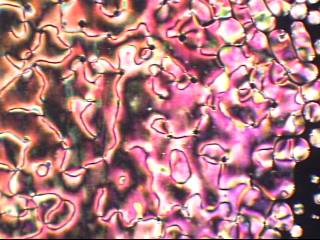
Research Interests
Liquid crystals are an industrially important class of compounds as they are used in a variety of displays for watches, calculators, and lap-top computers. The utility of liquid crystalline molecules arises because they can be oriented using an electric or magnetic field, and this reorientation drastically changes the way that light interacts with the molecules. The ability to be oriented is due to the fact that these compounds possess intermolecular interactions that are weaker than those found in solids and stronger than those found in liquids.
Unlike typical substances, which melt directly from a solid to a liquid, thermotropic liquid crystals undergo a phase transition from a solid to an intermediate phase (mesophase) before melting to an isotropic liquid upon further heating. In fact, many liquid crystals exhibit multiple mesophases. Liquid crystalline behavior is often observed for rod shaped molecules that possess a rigid core (typically consisting of aromatic rings), which provides order, and a flexible tail (such as an alkyl group), which provides disorder.
My research focuses on the synthesis and analysis of new organic and organometallic liquid crystals. In general, when examining a particular class of molecules for liquid crystalline behavior, a homologous series is prepared by systematically varying the length of the alkyl group. This is done because small changes in structure often lead to changes in liquid crystalline behavior. My students and I use standard organic and organometallic synthetic techniques to prepare our compounds, and NMR and IR spectroscopy to structurally characterize them. To study the liquid crystalline behavior, we use a polarizing microscope equipped with a heating stage and differential scanning calorimetry (DSC).
To learn more about liquid crystals see a "virtual textbook" on the subject.
An image of a liquid crystal phase (nematic phase) viewed with a polarizing
microscope.
Publications
Towards Room Temperature Biaxial Nematics, L. L. Cooper#, E.T. Samulski, E. Scharrer Mol. Cryst. Liq. Cryst. 2009, 511, 203.
Synthesis of New Liquid Crystalline Oxadiazole Derivatives: An Effort to Access the Biaxial Nematic Phase at Low Temperatures, N. Zafiropoulos, J. Lindborg#, M. Whittle#, L. Cooper#, E. T. Samulski, and E. Scharrer Polymer Preprints, 2008, 49(1), 618.
Synthesis and Phase Behavior of Liquid Crystalline Diphenylacetylene Derivatives Possessing High Clearing Temperatures, Douglas D. Young#, Mark V. Yoa#, and Eric Scharrer, Molecular Crystals and Liquid Crystals, 2004, 408, 21.
Co2(CO)6 Complexes of Alkyne Containing Liquid Crystals: A New Class of Metallomesogens, Douglas D. Young# and Eric Scharrer, Polymer Preprints, 2004, 45(1),
490.
# (denotes undergraduate co-author)
RUI: New oxadiazole containing liquid crystals: effects of structural changes on the biaxial nematic phase
NSF Division of Materials Research-Solid State and Materials Chemistry $148,000 June 2010 to May 2013.
Thermal Analysis Across the Undergraduate Chemistry Curriculum.
NSF-CCLI A&I $36,839 September 2000 to August 2003. (co-PIs: J. Crane, K. Rousslang, C. Mehlhaff, A. Wood)
Synthesis and Analysis of Liquid Crystalline Molecules Possessing Conjugated Cores.
ACS-PRF $20,000 September 1996 to August 2000.